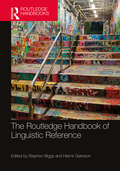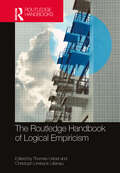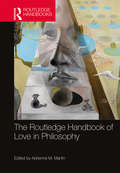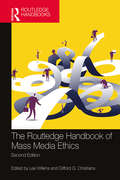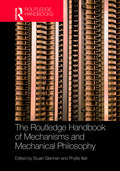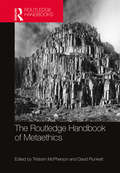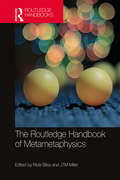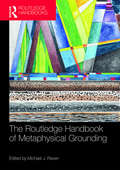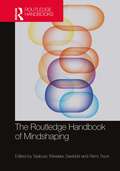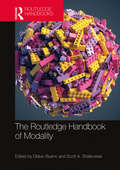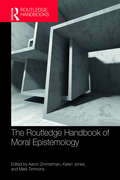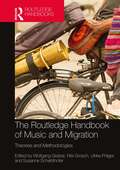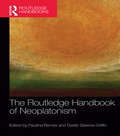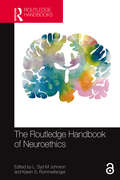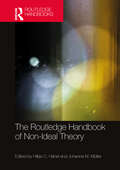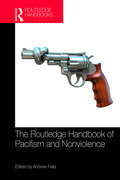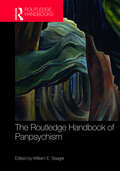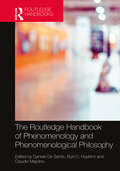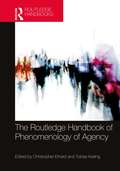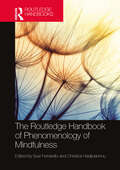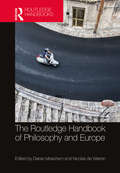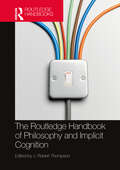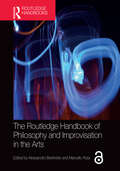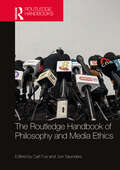- Table View
- List View
The Routledge Handbook of Linguistic Reference (Routledge Handbooks in Philosophy)
by Stephen BiggsThis Handbook offers students and more advanced readers a valuable resource for understanding linguistic reference; the relation between an expression (word, phrase, sentence) and what that expression is about. The volume’s forty-one original chapters, written by many of today’s leading philosophers of language, are organized into ten parts:I Early Descriptive TheoriesII Causal Theories of ReferenceIII Causal Theories and Cognitive SignificanceIV Alternate TheoriesV Two-Dimensional SemanticsVI Natural Kind Terms and RigidityVII The Empty CaseVIII Singular (De Re) ThoughtsIX IndexicalsX Epistemology of Reference Contributions consider what kinds of expressions actually refer (names, general terms, indexicals, empty terms, sentences), what referring expressions refer to, what makes an expression refer to whatever it does, connections between meaning and reference, and how we know facts about reference. Many contributions also develop connections between linguistic reference and issues in metaphysics, epistemology, philosophy of mind, and philosophy of science.
The Routledge Handbook of Logical Empiricism (Routledge Handbooks in Philosophy)
by Thomas Uebel Christoph Limbeck-LilienauLogical empiricism is a philosophical movement that flourished in the 1920s and 30s in Central Europe and in the 1940s and 50s in the United States. With its stated ambition to comprehend the revolutionary advances in the empirical and formal sciences of their day and to confront anti-modernist challenges to scientific reason itself, logical empiricism was never uncontroversial. Uniting key thinkers who often disagreed with one another but shared the aim to conceive of philosophy as part of the scientific enterprise, it left a rich and varied legacy that has only begun to be explored relatively recently. The Routledge Handbook of Logical Empiricism is an outstanding reference source to this challenging subject area, and the first collection of its kind. Comprising 41 chapters written by an international and interdisciplinary team of contributors, the Handbook is organized into four clear parts: The Cultural, Scientific and Philosophical Context and the Development of Logical Empiricism Characteristic Theses of and Specific Issues in Logical Empiricism Relations to Philosophical Contemporaries Leading Post-Positivist Criticisms and Legacy Essential reading for students and researchers in the history of twentieth-century philosophy, especially the history of analytical philosophy and the history of philosophy of science, the Handbook will also be of interest to those working in related areas of philosophy influenced by this important movement, including metaphysics and epistemology, philosophy of mind and philosophy of language.
The Routledge Handbook of Love in Philosophy (Routledge Handbooks in Philosophy)
by Adrienne M. MartinThe Routledge Handbook of Love in Philosophy collects 39 original chapters from prominent philosophers on the nature, meaning, value, and predicaments of love, presented in a unique framework that highlights the rich variety of methods and traditions used to engage with these subjects. This volume is structured around important realms of human life and activity, each of which receives its own section: I. Family and Friendship II. Romance and Sex III. Politics and Society IV. Animals, Nature, and the Environment V. Art, Faith, and Meaning VI. Rationality and Morality VII. Traditions: Historical and Contemporary. This last section includes chapters treating love as a subject in both Western and non-Western philosophical traditions. The contributions, all appearing in print here for the first time, are written to be accessible and compelling to non-philosophers and philosophers alike; and the volume as a whole encourages professional philosophers, teachers, students, and lay readers to rethink standard constructions of philosophical canons.
The Routledge Handbook of Mass Media Ethics
by Lee Wilkins Clifford G. ChristiansThis fully updated second edition of the popular handbook provides an exploration of thinking on media ethics, bringing together the intellectual history of global mass media ethics over the past 40 years, summarising existing research and setting future agenda grounded in philosophy and social science. This second edition offers up-to-date and comprehensive coverage of media ethics, including the ethics of sources, social media, the roots of law in ethics, and documentary film. The wide range of contributors include scholars and former professionals who worked as journalists, public relations professionals, and advertising practitioners. They lay out both a good grounding from which to begin more in-depth and individualized explorations, and extensive bibliographies for each chapter to aid that process. For students and professionals who seek to understand and do the best work possible, this book will provide both insight and direction. Standing apart in its comprehensive coverage, The Routledge Handbook of Mass Media Ethics is required reading for scholars, graduate students, and researchers in media, mass communication, journalism, ethics, and related areas.
The Routledge Handbook of Mechanisms and Mechanical Philosophy
by Phyllis Illari Stuart GlennanScientists studying the burning of stars, the evolution of species, DNA, the brain, the economy, and social change, all frequently describe their work as searching for mechanisms. Despite this fact, for much of the twentieth century philosophical discussions of the nature of mechanisms remained outside philosophy of science. The Routledge Handbook of Mechanisms and Mechanical Philosophy is an outstanding reference source to the key topics, problems, and debates in this exciting subject and is the first collection of its kind. Comprising over thirty chapters by a team of international contributors, the Handbook is divided into four Parts: Historical perspectives on mechanisms The nature of mechanisms Mechanisms and the philosophy of science Disciplinary perspectives on mechanisms. Within these Parts central topics and problems are examined, including the rise of mechanical philosophy in the seventeenth century; what mechanisms are made of and how they are organized; mechanisms and laws and regularities; how mechanisms are discovered and explained; dynamical systems theory; and disciplinary perspectives from physics, chemistry, biology, biomedicine, ecology, neuroscience, and the social sciences. Essential reading for students and researchers in philosophy of science, the Handbook will also be of interest to those in related fields, such as metaphysics, philosophy of psychology, and history of science.
The Routledge Handbook of Metaethics (Routledge Handbooks in Philosophy)
by Tristram McPherson David PlunkettThis Handbook surveys the contemporary state of the burgeoning field of metaethics. Forty-four chapters, all written exclusively for this volume, provide expert introductions to: the central research programs that frame metaethical discussions the central explanatory challenges, resources, and strategies that inform contemporary work in those research programs debates over the status of metaethics, and the appropriate methods to use in metaethical inquiry This is essential reading for anyone with a serious interest in metaethics, from those coming to it for the first time to those actively pursuing research in the field.
The Routledge Handbook of Metametaphysics (Routledge Handbooks in Philosophy)
by Ricki Bliss J.T.M. MillerPhilosophical questions regarding the nature and methodology of philosophical inquiry have garnered much attention in recent years. Perhaps nowhere are these discussions more developed than in relation to the field of metaphysics. The Routledge Handbook of Metametaphysics is an outstanding reference source to this growing subject. It comprises thirty-eight chapters written by leading international contributors, and is arranged around five themes: • The history of metametaphysics • Neo-Quineanism (and its objectors) • Alternative conceptions of metaphysics • The epistemology of metaphysics • Science and metaphysics. Essential reading for students and researchers in metaphysics, philosophical methodology, and ontology, The Routledge Handbook of Metametaphysics will also be of interest to those in closely related subjects such as philosophy of language, logic, and philosophy of science.
The Routledge Handbook of Metaphysical Grounding (Routledge Handbooks in Philosophy)
by Michael J. RavenSome of philosophy’s biggest questions, both historically and today, are in-virtue-of questions: In virtue of what is an action right or wrong? In virtue of what am I the same person my mother bore? In virtue of what is an artwork beautiful? Philosophers attempt to answer many of these types of in-virtue-of questions, but philosophers are also increasingly focusing on what an in-virtue-of question is in the first place. Many assume, at least as a working hypothesis, that in-virtue-of questions involve a distinctively metaphysical kind of determinative explanation called “ground.” This Handbook surveys the state of the art on ground as well as its connections and applications to other topics. The central issues of ground are discussed in 37 chapters, all written exclusively for this volume by a wide range of leading experts. The chapters are organized into the following sections: I. History II. Explanation and Determination III. Logic and Structure IV. Connections V. Applications Introductions at the start of each section provide an overview of the section’s contents, and a list of Related Topics at the end of each chapter points readers to other germane areas throughout the volume. The resulting volume is accessible enough for advanced students and informative enough for researchers. It is essential reading for anyone hoping to get clearer on what the biggest questions of philosophy are really asking.
The Routledge Handbook of Mindshaping (Routledge Handbooks in Philosophy)
by Daniel Kelly Wynn C. Stirling Michelle Maiese Jaroslav Peregrin Don Ross Sam Wilkinson Fredrik Stjernberg Shannon Spaulding Julian Kiverstein Ladislav Koreň Eric Funkhouser Ian Apperly Marc Slors Kristina Musholt Alessandra Tanesini Christopher Jude McCarroll Julia Wolf Fernando Martínez-Manrique Tadeusz Wiesław Zawidzki Rémi Tison Nikola Andonovski Virginia Ballesteros Leda Berio Devin Sanchez Curry Laura Danón Léon De Bruin John Dorsch Matej Drobňák Víctor Fernández-Castro Colum Finnegan Simon Fitzpatrick Marianna B. Ganapini Adam Gies Trip Glazer James Grayot J. P. Grodniewicz Núñez de Prado-Gordillo, Miguel Lucy Osler Dennis Papadopoulos Daniel Pérez-Zapata Uwe Peters Enrico Petracca Zuzanna Rucińska Ayana Samuel Derek Strijbos Brandon Tinklenberg Mason Westfall Evan WestraOf all species, human beings are uniquely capable of coordinating on long-term, large-scale cooperative projects with unfamiliar and genetically unrelated others. According to the mindshaping hypothesis, this relies on mechanisms and practices like imitation, pedagogy, normative cognition, and narrative self-constitution, which shape us into expert coordinators, without requiring time consuming and epistemically fraught attempts to read each other’s minds. Mindshaping has been applied to many areas of inquiry, including game theory, shared agency, communication, the ontogeny of human cognition, the dissemination of scientific knowledge in popular media, mental illness, and the influence of social media technologies.The Routledge Handbook of Mindshaping is the first volume of its kind. Comprising 37 chapters by an international team of leading scholars, this Handbook is organised into seven sections: Mindshaping and coordination Mindshaping and cognitive psychology Mindshaping and normativity Mindshaping and epistemology Social and political dimensions of mindshaping Nonhuman mindshaping Mindshaping applied Within these sections, key topics are addressed, including game theory, social signalling and shared agency, folk psychology, the emotions, language acquisition and memory, stereotyping and consciousness-raising, moral agency, self-knowledge, rationality, epistemic norms, primate sociality, human-elephant relations, artificial intelligence, mental illness and neurodiversity, aesthetic expression, and politics.An outstanding survey of a vibrant and emerging field, The Routledge Handbook of Mindshaping will be of great interest to those studying and researching philosophy of psychology, philosophy of cognitive science, philosophy of mind, and applied epistemology. It will also be of interest to those in related disciplines such as cognitive psychology, sociology, and anthropology.
The Routledge Handbook of Modality (Routledge Handbooks in Philosophy)
by Otávio Bueno Scott A. ShalkowskiModality - the question of what is possible and what is necessary - is a fundamental area of philosophy and philosophical research. The Routledge Handbook of Modality is an outstanding reference source to the key topics, problems and debates in this exciting subject and is the first collection of its kind. Comprising thirty-five chapters by a team of international contributors the Handbook is divided into seven clear parts: worlds and modality essentialism, ontological dependence, and modality modal anti-realism epistemology of modality modality in science modality in logic and mathematics modality in the history of philosophy. Within these sections the central issues, debates and problems are examined, including possible worlds, essentialism, counterfactuals, ontological dependence, modal fictionalism, deflationism, the integration challenge, conceivability, a priori knowledge, laws of nature, natural kinds, and logical necessity. The Routledge Handbook of Modality is essential reading for students and researchers in epistemology, metaphysics and philosophy of language. It will also be very useful for those in related fields in philosophy such as philosophy of mathematics, logic and philosophy of science.
The Routledge Handbook of Moral Epistemology (Routledge Handbooks in Philosophy)
by Mark Timmons Karen Jones Aaron ZimmermanThe Routledge Handbook of Moral Epistemology brings together philosophers, cognitive scientists, developmental and evolutionary psychologists, animal ethologists, intellectual historians, and educators to provide the most comprehensive analysis of the prospects for moral knowledge ever assembled in print. The book’s thirty chapters feature leading experts describing the nature of moral thought, its evolution, childhood development, and neurological realization. Various forms of moral skepticism are addressed along with the historical development of ideals of moral knowledge and their role in law, education, legal policy, and other areas of social life. Highlights include: • Analyses of moral cognition and moral learning by leading cognitive scientists • Accounts of the normative practices of animals by expert animal ethologists • An overview of the evolution of cooperation by preeminent evolutionary psychologists • Sophisticated treatments of moral skepticism, relativism, moral uncertainty, and know-how by renowned philosophers • Scholarly accounts of the development of Western moral thinking by eminent intellectual historians • Careful analyses of the role played by conceptions of moral knowledge in political liberation movements, religious institutions, criminal law, secondary education, and professional codes of ethics articulated by cutting-edge social and moral philosophers.
The Routledge Handbook of Music and Migration: Theories and Methodologies (Routledge Music Handbooks)
by Nils Grosch Wolfgang Gratzer Ulrike Präger Susanne ScheiblhoferThe Routledge Handbook of Music and Migration: Theories and Methodologies is a progressive, transdisciplinary paradigm-shifting core text for music and migration studies. Conceptualized as a comprehensive methodological and theoretical guide, it foregrounds the mobile potentials of music and presents key arguments about why musical expressions matter in the discussion of migration politics. 24 international specialists in music and migration set methodological and theoretical standards for transdisciplinary collaborations in the field of migration studies, discussing 41 keywords, such as mobility, community, research ethics, human rights, and critical whiteness in the context of music and migration. The authors then apply these terms to 16 chapters, which deal with ethnomusicological, musicological, sociological, anthropological, geographical, pedagogical, political, economic, and media-related methodologies and theories which reflect and contest current discourses of migration. In their interdisciplinary focus, these chapters advance interrelations between music and migration as enabling factors for socio-cultural studies. Furthermore, the authors tackle crucial questions of agency, equality, and equity as well as the responsibilities and expectations of writers and artists when researching migration phenomena as innate human experience. As a result, this handbook provides scholars and students alike with relevant and applicable methodological and theoretical tools in addition to an extensive literature and research review for further research.
The Routledge Handbook of Neoplatonism (Routledge Handbooks in Philosophy)
by Edited by Pauliina Remes and Svetla Slaveva-GriffinThe Routledge Handbook of Neoplatonism is an authoritative and comprehensive survey of the most important issues and developments in one of the fastest growing areas of research in ancient philosophy. An international team of scholars situates and re-evaluates Neoplatonism within the history of ancient philosophy and thought, and explores its influence on philosophical and religious schools worldwide. Over thirty chapters are divided into seven clear parts: (Re)sources, instruction and interaction Methods and Styles of Exegesis Metaphysics and Metaphysical Perspectives Language, Knowledge, Soul, and Self Nature: Physics, Medicine and Biology Ethics, Political Theory and Aesthetics The legacy of Neoplatonism. The Routledge Handbook of Neoplatonism is a major reference source for all students and scholars in Neoplatonism and ancient philosophy, as well as researchers in the philosophy of science, ethics, aesthetics and religion.
The Routledge Handbook of Neuroethics (Routledge Handbooks in Applied Ethics)
by L. Syd Johnson Karen S. RommelfangerThe Routledge Handbook of Neuroethics offers the reader an informed view of how the brain sciences are being used to approach, understand, and reinvigorate traditional philosophical questions, as well as how those questions, with the grounding influence of neuroscience, are being revisited beyond clinical and research domains. It also examines how contemporary neuroscience research might ultimately impact our understanding of relationships, flourishing, and human nature. Written by 61 key scholars and fresh voices, the Handbook’s easy-to-follow chapters appear here for the first time in print and represent the wide range of viewpoints in neuroethics. The volume spotlights new technologies and historical articulations of key problems, issues, and concepts and includes cross-referencing between chapters to highlight the complex interactions of concepts and ideas within neuroethics. These features enhance the Handbook’s utility by providing readers with a contextual map for different approaches to issues and a guide to further avenues of interest.
The Routledge Handbook of Non-Ideal Theory (Routledge Handbooks in Philosophy)
by Johanna M. Müller Hilkje C. HänelMade popular by John Rawls, ideal theory in political philosophy is concerned with putting preferences and interests to one side to achieve an impartial consensus and to arrive at a just society for all. In recent years, ideal theory has drawn increasing criticism for its idealised picture of political philosophy and its inability to account for the challenges posed by inequalities of, for example, race, gender, and class and by structural injustices stemming from colonialism and imperialism. The Routledge Handbook of Non-Ideal Theory is the first handbook or reference source on this important and fast-growing debate.Comprised of 34 chapters by an international team of contributors, the Handbook is divided into three clear parts: Methodological Challenges Intersections Applied Issues and Contemporary Challenges Within these sections key topics are addressed including: the question of whether non-ideal theory is methodologically linked to ideal theory; its intersection with feminist philosophy, critical race theory, decolonial theory, and critical theory; its characteristic features; the role of the non-ideal theorist; its relation to activism; and its application in the context of disability and health studies, climate justice, global injustices, colonialism, and many more. As well as a comprehensive introduction which provides important background to the debate between ideal and non-ideal theory, the Handbook also features a contribution by the late philosopher Charles Mills on non-ideal theory as ideology.The Routledge Handbook of Non-Ideal Theory is essential reading for students and scholars of political philosophy, ethics, and political theory, and will also be of interest to those studying and researching related subjects such as gender, race, and social justice.
The Routledge Handbook of Pacifism and Nonviolence (Routledge Handbooks in Philosophy)
by Andrew FialaInterest in pacifism—an idea with a long history in philosophical thought and in several religious traditions—is growing. The Routledge Handbook of Pacifism and Nonviolence is the first comprehensive reference designed to introduce newcomers and researchers to the many varieties of pacifism and nonviolence, to their history and philosophy, and to pacifism’s most serious critiques. The volume offers 32 brand new chapters from the world’s leading experts across a diverse range of fields, who together provide a broad discussion of pacifism and nonviolence in connection with virtue ethics, capital punishment, animal ethics, ecology, queer theory, and feminism, among other areas. This Handbook is divided into four sections: (1) Historical and Tradition-Specific Considerations, (2) Conceptual and Moral Considerations, (3) Social and Political Considerations, and (4) Applications. It concludes with an Afterword by James Lawson, one of the icons of the nonviolent American Civil Rights movement. The text will be invaluable to scholars and students, as well as to activists and general readers interested in peace, nonviolence, and critical perspectives on war and violence.
The Routledge Handbook of Panpsychism (Routledge Handbooks in Philosophy)
by William SeagerPanpsychism is the view that consciousness – the most puzzling and strangest phenomenon in the entire universe – is a fundamental and ubiquitous feature of the world, though in a form very remote from human consciousness. At a very basic level, the world is awake. Panpsychism seems implausible to most, and yet it has experienced a remarkable renaissance of interest over the last quarter century. The reason is the stubbornly intractable problem of consciousness. Despite immense progress in understanding the brain and its relation to states of consciousness, we still really have no idea how consciousness emerges from physical processes which are presumed to be entirely non-conscious. The Routledge Handbook of Panpsychism provides a high-level comprehensive examination and assessment of the subject – its history and contemporary development. It offers 28 chapters, appearing in print here for the first time, from the world’s leading researchers on panpsychism. The chapters are divided into four sections that integrate panpsychism’s relevance with important issues in philosophy of mind, philosophy of science, metaphysics, and even ethics: Historical Reflections Forms of Panpsychism Comparative Alternatives How Does Panpsychism Work? The volume will be useful to students and scholars as both an introduction and as cutting-edge philosophical engagement with the subject. For anyone interested in a philosophical approach to panpsychism, the Handbook will supply fascinating and enlightening reading. The topics covered are highly diverse, representing a spectrum of views on the nature of mind and world from various standpoints which take panpsychism seriously.
The Routledge Handbook of Phenomenology and Phenomenological Philosophy (Routledge Handbooks in Philosophy)
by Daniele De Santis, Burt C. Hopkins and Claudio MajolinoPhenomenology was one of the twentieth century’s major philosophical movements, and it continues to be a vibrant and widely studied subject today with relevance beyond philosophy in areas such as medicine and cognitive sciences. The Routledge Handbook of Phenomenology and Phenomenological Philosophy is an outstanding guide to this important and fascinating topic. Its focus on phenomenology’s historical and systematic dimensions makes it a unique and valuable reference source. Moreover, its innovative approach includes entries that don’t simply reflect the state-of-the-art but in many cases advance it. Comprising seventy-five chapters by a team of international contributors, the Handbook offers unparalleled coverage and discussion of the subject, and is divided into five clear parts: • Phenomenology and the history of philosophy • Issues and concepts in phenomenology • Major figures in phenomenology • Intersections • Phenomenology in the world. Essential reading for students and researchers in philosophy studying phenomenology, The Routledge Handbook of Phenomenology and Phenomenological Philosophy is also suitable for those in related disciplines such as psychology, religion, literature, sociology and anthropology.
The Routledge Handbook of Phenomenology of Agency (Routledge Handbooks in Philosophy)
by Christopher Erhard Tobias KeilingPhenomenology has primarily been concerned with questions about knowledge and ontology. However, in recent years the rise of interest and research in phenomenology and embodiment, the emotions and cognitive science has seen the concept of agency move to a central place in the study of phenomenology generally. The Routledge Handbook of Phenomenology of Agency is an outstanding reference source to this topic and the first volume of its kind. It comprises twenty-seven chapters written by leading international contributors. Organised into two parts, the following key topics are covered: • major figures• the metaphysics of agency• rationality• voluntary and involuntary action• moral experience• deliberation and choice• phenomenology of agency and the cognitive sciences• phenomenology of freedom• embodied agency Essential reading for students and researchers in phenomenology, philosophy of mind, metaphysics and philosophy of cognitive science The Routledge Handbook of Phenomenology of Agency will also be of interest to those in closely related subjects such as sociology and psychology.
The Routledge Handbook of Phenomenology of Emotion (Routledge Handbooks in Philosophy)
by Thomas Szanto Hilge LandweerThe emotions occupy a fundamental place in philosophy, going back to Aristotle. However, the phenomenology of the emotions has until recently remained a relatively neglected topic. The Routledge Handbook of Phenomenology of Emotion is an outstanding guide and reference source to this important and fascinating topic. Comprising forty-nine chapters by a team of international contributors, this handbook covers the following topics: historical perspectives, including Brentano, Husserl, Sartre, Levinas and Arendt; contemporary debates, including existential feelings, situated affectivity, embodiment, art, morality and feminism; self-directed and individual emotions, including happiness, grief, self-esteem and shame; social emotions, including sympathy, aggresive emotions, collective emotions and political emotions; borderline cases of emotion, including solidarity, trust, pain, forgiveness and revenge. Essential reading for students and researchers in philosophy studying phenomenology, ethics, moral psychology and philosophy of psychology, The Routledge Handbook of Phenomenology of Emotion is also suitable for those in related disciplines such as religion, sociology and anthropology.
The Routledge Handbook of Phenomenology of Mindfulness (Routledge Handbooks in Philosophy)
by Susi Ferrarello Christos HadjioannouThe Routledge Handbook of Phenomenology of Mindfulness brings together two schools of thought and practice that – despite rarely being examined jointly – provide an incredibly fruitful way for exploring thinking, the mind, and the nature and practice of mindfulness. Applying the concepts and methods of phenomenology, an international team of contributors explore mindfulness from a variety of different viewpoints and traditions. The handbook’s 35 chapters are divided into seven clear parts: Mindfulness in the Western Traditions Mindfulness in the Eastern Traditions Mindfulness, Ethics, and Well-Being Mindfulness, Time, and Attention Mindfulness and Embodiment Applications: Mindfulness in Life Conclusion: Mindfulness and Phenomenology? Within these sections, a rich array of topics and themes are explored, ranging from Stoicism and the origins of mindfulness in Buddhism and eastern thought to meditation, self-awareness, the body and embodiment, and critiques of mindfulness. Additionally, the book delves into the ways the ideas of leading phenomenological thinkers, including Heidegger, Merleau-Ponty, and Levinas, can contribute to understanding the relationship between phenomenology and mindfulness. A valuable resource for those researching phenomenology and applications of phenomenology, this handbook will also be of great interest to students and practitioners of mindfulness in areas such as counseling and psychotherapy.
The Routledge Handbook of Philosophy and Europe (Routledge Handbooks in Philosophy)
by Darian Meacham; Nicolas de WarrenUnderstood historically, culturally, politically, geographically, or philosophically, the idea of Europe and notion of European identity conjure up as much controversy as consensus. The mapping of the relation between ideas of Europe and their philosophical articulation and contestation has never benefitted from clear boundaries, and if it is to retain its relevance to the challenges now facing the world, it must become an evolving conceptual landscape of critical reflection. The Routledge Handbook of Philosophy and Europe provides an outstanding reference work for the exploration of Europe in its manifold conceptions, narratives, institutions, and values. Comprising twenty-seven chapters by a group of international contributors, the Handbook is divided into three parts: Europe of the philosophers Concepts and controversies Debates and horizons. Essential reading for students and researchers in philosophy, politics, and European studies, the Handbook will also be of interest to those in related disciplines such as sociology, religion, and European history and history of ideas.
The Routledge Handbook of Philosophy and Implicit Cognition (Routledge Handbooks in Philosophy)
by J. Robert ThompsonHumans think of ourselves as acting according to reasons that we can typically articulate and acknowledge, though we may be reluctant to do so. Yet some of our actions do not fit this mold—they seem to arise from motives and thoughts that appear outside of our control and our self-awareness. Rather than treating such cases as outliers, theorists now treat significant parts of the mind as operating implicitly or ‘behind the scenes’. Mental faculties like reasoning, language, and memory seem to involve this sort of implicit cognition, and many of the structures we use to understand one another seem infused with biases, perceptions, and stereotypes that have implicit features. The Routledge Handbook of Philosophy and Implicit Cognition is an outstanding guide and reference source to this important topic. Composed of more than thirty chapters by an international team of contributors, the Handbook is divided into eight clear parts: Defining Features? Identifying Implicitness Among Cognate Notions The Nature and Limits of Implicit Processing Ways of Perceiving, Knowing, Believing Language Agency and Control Social Cognition Memory Learning and Reasoning. The Routledge Handbook of Philosophy and Implicit Cognition is essential reading for students and researchers in philosophy of psychology, moral psychology, and philosophy of mind, and will also be of interest to those in related disciplines such as psychology, neuroscience, and linguistics.
The Routledge Handbook of Philosophy and Improvisation in the Arts (Routledge Handbooks in Philosophy)
by Alessandro Bertinetto Marcello RutaOver the last few decades, the notion of improvisation has enriched and dynamized research on traditional philosophies of music, theatre, dance, poetry, and even visual art. This Handbook offers readers an authoritative collection of accessible articles on the philosophy of improvisation, synthesizing and explaining various subjects and issues from the growing wave of journal articles and monographs in the field. Its 48 chapters, written specifically for this volume by an international team of scholars, are accessible for students and researchers alike. The volume is organized into four main sections:I Art and Improvisation: Theoretical PerspectivesII Art and Improvisation: Aesthetical, Ethical, and Political PerspectivesIII Improvisation in Musical PracticesIV Improvisation in the Visual, Narrative, Dramatic, and Interactive Arts Key Features: Treats improvisation not only as a stylistic feature, but also as an aesthetic property of artworks and performances as well as a core element of artistic creativity. Spells out multiple aspects of the concept of improvisation, emphasizing its relevance in understanding the nature of art. Covers improvisation in a wide spectrum of artistic domains, including unexpected ones such as literature, visual arts, games, and cooking. Addresses key questions, such as:- How can improvisation be defined and what is its role in different art forms?- Can improvisation be perceived as such, and how can it be aesthetically evaluated?- What is the relationship between improvisation and notions such as action, composition, expressivity, and authenticity?- What is the ethical and political significance of improvisation?
The Routledge Handbook of Philosophy and Media Ethics (Routledge Handbooks in Applied Ethics)
by Joe Saunders Carl FoxThe media informs, entertains, and connects us. It is woven into the fabric of politics. Its increasing immediacy has become an inescapable feature of almost everybody’s life. We are, at the same time, subject to the media and participants in it. The ethical questions it raises have never been more urgent. Trust is in short supply, but we need to share information while dealing with problems like misinformation, disinformation, and echo chambers. And what responsibilities fall on the state, and on other actors such as artists, advertisers, and social media users, as we reckon with endemic problems like racism, sexism, and classism? The Routledge Handbook of Philosophy and Media Ethics is an outstanding survey and assessment of this vitally important field. Comprising thirty chapters written by an international team of contributors, the Handbook is divided into five parts: • Freedom of Speech, Privacy, and Censorship• The News Media• Broadening the Scope: Giving Other Aspects of the Media their Due• Justice, Power, and Representation• Vice and Virtue Online The Routledge Handbook of Philosophy and Media Ethics is essential reading for students and researchers in philosophy, media and communication studies, politics, and law, as well as practising media professionals and journalists.
